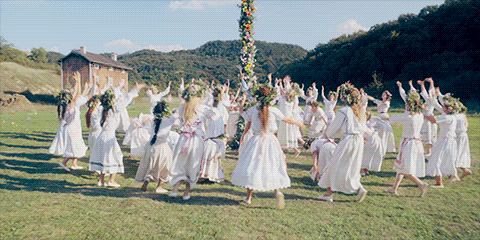Folk Horror: Your New Obsession
By Fiona Golden
When I first saw Midsommar last July, I became obsessed to say the least. Ari Aster is a brilliant horror director and I was excited to see how his latest film would compare to Hereditary. So, I sat through the film, my eyes glued to the screen while my friends looked away in disgust. Parts of Midsommar were some of the most disturbing scenes I’d ever seen but I was mesmerized. How on earth could a director make people want to see these images, much less willingly ponder them. I walked out of the theatre feeling like maybe I should talk to my therapist about all this. But as I talked with others and scrolled through Film Twitter’s takes, I realized everyone was pretty much in the same boat: that movie was outstanding.
In the 1960s and 70s, interest in Paganism manifested from an era of social revolution. This was reflected in a lot of films from the time, including The Wicker Man (1973). Its plot is strikingly similar to that of Midsommar; an outsider from the “modern” world is sent over to a remote location, in this case a small island in Northern Scotland. Though things are slightly odd and eerie to begin with, the protagonist quickly discovers that, well, sh*t’s crazy here. Both films have running themes of ritualistic sex, effigies, polytheism, festival celebrations, and natural incarnation. What really makes The Wicker Man shine, I believe, is its synthesis of nonchalance among the villagers and the protagonist’s steadfast Christianity. The final scene is the crown jewel of the movie, chilling to the bone. Add in some traditional Celtic folk songs and you’ve got yourself a masterpiece.
Folk horror, at its core, is revolutionary for its overall genre. It doesn’t rely on excessive gore – although there are certainly disturbing murders and distorted anatomies. Folk horror doesn’t exactly break the fake blood bank. Instead of jump scares and screechy soundtracks, the sun shines and we see beautiful shots of nature accompanied by traditional music. Arguably, this is what makes the whole situation more terrifying. It’s the idea that all of this madness is normal for everyone in the commune. We see both the outsider’s perspective of utter disbelief and terror and the contentedness and celebration from the villagers.
If you’re interested in delving into folk horror, writer and filmmaker Adam Scovell has written a fantastic guide to the genre, which you can read below.
https://www.bfi.org.uk/news-opinion/news-bfi/features/where-begin-folk-horror
Note: If you’re going to watch The Wicker Man, make sure you’re watching the original 1973 version. There was a 2006 version with Nicolas Cage, and it was absolutely ripped to shreds by critics. It is an award-winning film however- the winner of Stinkers Bad Movie Awards for Worst Remake.
Images belong to Ari Aster’s Midsommar (2019), A24 and Robin Hardy’s The Wicker Man (1973), British Lion Films


